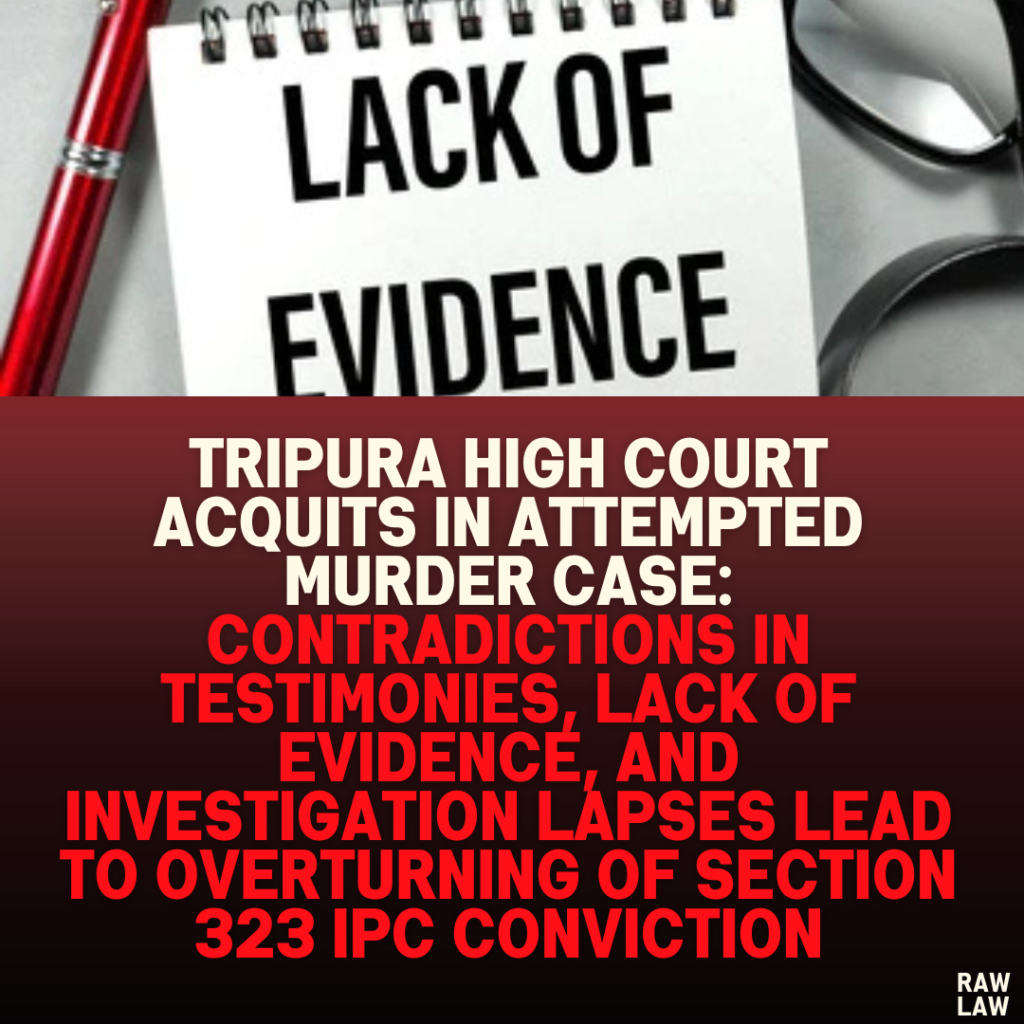Court’s Decision:
The High Court of Tripura overturned the conviction of the appellant under Section 323 of the Indian Penal Code (IPC), citing inconsistencies in witness testimonies, lack of critical corroborative evidence, and procedural lapses in the investigation. The Court allowed the appeal, acquitted the appellant on the benefit of the doubt, and ordered his release.
Facts:
- The case originated from an FIR filed on October 8, 2017, by the victim’s father, alleging that the appellant lured the victim out of his house and attacked him with a knife, causing injuries to his throat, hands, and legs.
- The appellant was charged under Section 307 IPC (attempt to murder) based on the victim’s initial injuries and subsequent hospitalization.
- During trial, the prosecution presented 10 witnesses, including the victim, his parents, and the investigating officers. However, the trial court found insufficient evidence to sustain the charge under Section 307 IPC and convicted the appellant under Section 323 IPC (causing hurt) instead.
- The appellant was sentenced to six months of rigorous imprisonment and fined ₹1,000, with a further one-month imprisonment in case of default.
Issues:
- Procedural and Evidentiary Gaps: Whether inconsistencies in witness testimonies and absence of corroborative evidence undermined the trial court’s conviction.
- Prosecution’s Case: Whether the prosecution successfully established guilt beyond a reasonable doubt.
- Downgrading of Charge: Whether the trial court was justified in altering the charge from Section 307 IPC to Section 323 IPC in light of the evidence.
Petitioner’s Arguments:
- Contradictory Testimonies: The appellant’s counsel highlighted significant contradictions between witness statements recorded during the investigation (under Section 161 of CrPC) and their in-court depositions. These contradictions undermined their credibility.
- The victim and his parents altered their descriptions of the place of occurrence, the events leading up to the incident, and the injuries sustained.
- Failure to Seize Crucial Evidence: No weapon, blood-stained clothing, or other physical evidence, such as the gamcha allegedly used by the victim to wrap his neck, was presented in court.
- Medical Evidence: The medical report stated that the victim’s injuries were caused by a blunt object, conflicting with the prosecution’s claim that a knife was used.
- Place of Occurrence: Prosecution witnesses provided conflicting accounts of the place of occurrence, which was variously described as a drain, the backyard of a house, or near a pond.
- Application of Precedents: The counsel cited legal precedents to emphasize the need for corroborative evidence and consistent testimonies to sustain a conviction.
Respondent’s Arguments:
- Reliability of Victim’s Testimony: The prosecution argued that minor discrepancies in the victim’s testimony should not overshadow its overall reliability. As an injured witness, the victim’s account carried significant evidentiary value.
- Corroborative Accounts: The victim’s parents corroborated his account, particularly regarding the injuries and the appellant’s alleged motive of revenge due to a land dispute.
- Reasonableness of Trial Court’s Decision: The trial court’s decision to convict under Section 323 IPC instead of Section 307 IPC demonstrated a fair appreciation of the evidence.
Analysis of the Law:
- Downgrading Charges: The trial court downgraded the charge from Section 307 IPC to Section 323 IPC due to the lack of evidence showing intent to kill. However, this raised questions about the sufficiency of evidence to even sustain the lesser charge.
- Contradictions and Witness Credibility: The High Court observed significant contradictions between witness testimonies and their earlier statements to the police, particularly regarding:
- The sequence of events.
- The location of the incident.
- The description of the injuries.
- Lack of Physical Evidence: The absence of the alleged weapon and blood-stained items weakened the prosecution’s case. The investigating officer failed to seize or produce these critical pieces of evidence.
- Medical Evidence: The injuries described by the medical officer were inconsistent with the prosecution’s claim of a knife attack, as the wounds were attributed to a blunt object.
Precedent Analysis:
The Court relied on several precedents to guide its decision:
- Syed Ibrahim v. State of Andhra Pradesh (2006): Witness contradictions and inability to establish the place of occurrence can discredit the prosecution’s case.
- Mani Ram v. State of Uttar Pradesh (1994): Discrepancies between medical evidence and eyewitness accounts undermine the prosecution.
- State of Haryana v. Inderaj (1993): Interested witnesses require corroboration to avoid wrongful convictions.
- Birbal Nath v. State of Rajasthan (2023): While minor contradictions do not render a witness’s testimony unreliable, substantial contradictions that affect material facts warrant rejection of their evidence.
Court’s Reasoning:
- Witness Testimonies: The Court found that the victim and his parents made material improvements in their testimonies during the trial, deviating from their initial police statements. This affected their credibility.
- Investigation Lapses: The failure to seize the weapon or collect physical evidence raised doubts about the thoroughness of the investigation.
- Inconsistent Medical Findings: The medical officer’s report, which attributed the injuries to a blunt object, conflicted with the prosecution’s claim of a knife attack.
- Lack of Corroboration: No independent witnesses or forensic evidence substantiated the prosecution’s case.
Conclusion:
The High Court concluded that the evidence presented by the prosecution suffered from significant infirmities. The contradictions in witness testimonies and absence of critical evidence created reasonable doubt about the appellant’s guilt. The Court set aside the conviction and acquitted the appellant, granting him the benefit of the doubt.
Implications:
- Fair Trial Principles: This judgment reinforces the importance of thorough investigations and consistent, credible witness testimonies in criminal trials.
- Burden of Proof: It underscores that the prosecution must prove guilt beyond a reasonable doubt, particularly in cases involving serious charges like attempted murder.
- Investigation Standards: The case highlights the need for stricter adherence to procedural norms, including the seizure and production of physical evidence.
